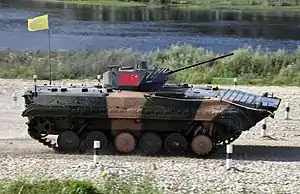Type 86 (infantry fighting vehicle)
The Type 86, also known as WZ501, is a Chinese copy of the Russian BMP-1 infantry fighting vehicle (IFV).
| Type 86 IFV | |
|---|---|
 Type 86G at Tank Biathlon 2016 | |
| Type | Infantry fighting vehicle |
| Place of origin | China |
| Service history | |
| In service | 1992–present |
| Specifications | |
| Mass | 13.3 t (14.7 short tons; 13.1 long tons) |
| Length | 6.74 m (22 ft 1 in)[1] |
| Width | 2.97 m (9 ft 9 in)<[1] |
| Height | 2.16 m (7 ft 1 in)<[1] |
| Crew | 3 |
| Passengers | 8 |
| Armor | Welded steel |
Main armament | Type 86: 73 mm gun Type 86G: 30 mm autocannon |
Secondary armament | 7.62 mm coaxial machine gun HJ-73 anti-tank missiles |
| Engine | diesel 298 hp |
| Suspension | Torsion bar |
Operational range | 500 km (310 mi) |
| Maximum speed | 65 km/h (40 mph) (road) 8 km/h (5.0 mph; 4.3 kn) (water) |
Design
When infantry fighting vehicles appeared between the United States and the Soviet Union in the 1970s, China was in a chaotic period of Cultural Revolution and there was no plan for infantry fighting vehicles. In Sino–Vietnamese War, the Vietnamese army often harassed in the form of small units. The Chinese army seized the defect that People's Liberation Army had no infantry fighting vehicles. Most infantrymen accompanied the development of offensive tank forces on foot or in tanks. They attacked the front and rear vehicles of the tank convoy in the narrow mountainous area, and used the unshielded infantry, and even used the method of blasting the dam to flood the road, slowing the advancement of the Chinese army, directly stimulating China’s motivation to develop infantry fighting vehicles.[2]
In the 1980s, through the exchange of maintenance and maintenance of Soviet-style equipment for Egypt, the North China Vehicle Manufacturing Plant obtained the BMP-1 tank produced by the Soviet Union from the Egyptian Army, which was surveyed and copied by the 627 Plant. The factory product code was "WZ" -501", a prototype vehicle was launched for testing in 1984. In 1986, the WZ-501 was successfully imitated and finalized, namely the 86-type crawler infantry fighting vehicle. At first, the domestic equipment was not considered, mainly for the needs of military trade and export. Mass production of parts and components, and delivery to foreign users. Mass production and installation of the People's Liberation Army began in 1992, becoming the first type of infantry fighting vehicle formally adopted by the PLA Army. The first batch was delivered to the 38th Army in 1993. A total of about 1,000 vehicles are equipped, concentrated in the mechanized units of the Army Group Army in the northern part of mainland China.
Variants
- Type 86 – A Chinese copy of the BMP-1 (Ob'yekt 765Sp3). It is armed with an ATGM launcher for the HJ-73 "Red Arrow 73" ATGM which is a copy of the Soviet 9M14 "Malyutka". It is powered by the Type 6V150 diesel engine which is a copy of the Soviet UTD-20. Equipment includes the A-220A radio (a copy of the Soviet R-123M), A-221A intercom (a copy of the Soviet R-124), two 7.62 mm machine guns, a 40 mm rocket propelled grenade (RPG) launcher and a HN-5 or QW-1 MANPADS. Its industrial designation is WZ-501.[3][4]
- WZ-501 – Converted into an NBC reconnaissance vehicle with a raised troop compartment.[5]
- WZ-501 – Converted into a battlefield surveillance vehicle.[3]
- YW-501 – Export variant of WZ-501.
- NFV-1 (N stands for NORINCO, F stands for FMC and V-1 stands for Vehicle 1) – An export variant which was the product of a co-operative project between the Chinese NORINCO and US FMC companies in the 1980s. Its goal was to fit a FMC large vertical slab-sided turret with a chamfered front called "Sharpshooter", onto a modified Type 86 hull. It was to be armed with a 25 mm M242 Bushmaster autocannon with a two plane stabilization system and a 7.62 mm M240 coaxial machine gun (on the left hand side of the main gun). The vehicle carries 344 rounds for the main gun, 200 rounds are for 'ready use' while 144 are kept in storage. 2,300 rounds are carried for the machine gun. The gun is moved in the horizontal and vertical planes by an electromechanical system, it can also be moved manually. The gun can be depressed or elevated between −7° and +44°. The gunner has the М36Е3 dual mode day/night sight and 4 periscope vision blocks which are located in the front and on the sides of the turret. Also an additional periscope vision block can be fitted to the back of the turret. The tracks have been slightly modified. As the result of all these changes the weight of the vehicle increased to 13.6 tonnes and the maximum range was reduced to 460 km. The vehicle is also wider (2.97 m) and higher (2,248 m). The prototype was shown to the public for the first time in November 1986. It never left the prototype stage because the US government prohibited any further collaboration with China.[3][6]
- Type 86-I – Improved variant of the Type 86 designed by the Chinese together with the US FMC company at the end of the 1980s. It is fitted with a one-man overhead mount turret armed with a licensed copy of the 25 mm M242 Bushmaster autocannon and a coaxial 7.62 mm Type 59 machine gun. The overhead mount turret is the same as the one on the ZSL92 wheeled IFV. The vehicle carries 400 rounds for the main gun and 2000 rounds for the machine gun. It is powered by a new 6V150F 29.41-litre diesel engine which is a powered-up version of the 6V150. It develops 400 hp (298 kW). Maximum road speed has increased to 70 km/h. The tracks have been slightly modified. The weight of the vehicle has increased to 13.6 tonnes. 350 were produced. Its industrial designation is WZ-501A. It is also called Type 86-1.[3][7]
 A Type 86A infantry fighting vehicle
A Type 86A infantry fighting vehicle - Type 86A – Modernization fitted with a new turret armed with a 30 mm autocanon although the ATGM launcher for the HJ-73 ATGMs was retained and is positioned on the right hand side of the roof of the turret. The turret was equipped with two clusters of three smoke grenade launchers (one on each side of the turret). It is sometimes called the Type 86Gai, G stands for Gai – improved, overall, it is broadly equivalent to a BMP-2.[3]
- Type 86B – Variant developed by NORINCO for Chinese naval infantry. It features a slightly higher hull, an amphibious kit, an exhaust extension, a bow extension, a larger trim vane, a mount for an outboard motor on the rear of the hull to improve its swimming performance, a raised engine air intake on the right hand side of the front of the hull, detachable pontoons in the front and rear of the hull, a high snorkel and large side screens for better streamlining. Also the turret was improved by adding two clusters of three smoke grenade launchers (one on each side of the turret). Its industrial designation is WZ-501C.[3][8]
- WZ-502 – WZ-501 equipped with a mortar.
- WZ-503 – WZ-501 converted into an APC. It lacks the turret and has a taller troop compartment. The number of passengers was increased from 8 to 13. The vehicle's armament consists of one centrally mounted 12.7 mm heavy machine gun operated by the commander/gunner. It did not leave the prototype stage.[3][9]
- WZ-504 (Type 504) – The troop compartment was replaced by a weapons compartment which incorporates an elevatable weapon station armed with four HJ-73 "Red Arrow 73" cable-guided ATGM rail launchers mounted under the roof of the weapons station and equipped with optical sights. The launcher can be retracted into the compartment when not in use. The vehicle carries 16 ATGMs. It never left the prototype stage.[3][9]
- WZ-505 – WZ-501 converted into an armored ambulance with raised troop compartment and armed with one machine gun.[9]
Gallery
 Early variant for Type 86
Early variant for Type 86
Operators
See also
- BMP-1
- BMP-2
- BMP-3
- BMP development
- ZBD-04
- MLI-84 – a Romanian IFV based on a modified BMP chassis
- BMP-23
- Dardo IFV
- Marder (IFV)
- Lazika
- M2 Bradley [10]
- Combat Vehicle 90
- ASCOD
- Warrior IFV
- BVP M80 IFV
References
- "Type 86 Infantry fighting vehicle". Military-Today.
- "从BMP-1看中国86式步兵战车". 《坦克装甲车辆》 (in Chinese). 新浪军事. 2005-09-19. Archived from the original on 2016-03-04. Retrieved 2012-08-16.
- Sino Defense Archived 23 January 2012 at the Wayback Machine. Sinodefence.com (20 February 2009). Retrieved 20 September 2011.
- "WZ 501 YW 501 Type 86 armoured infantry fighting vehicle". 18 August 2013. Archived from the original on 15 August 2013. Retrieved 19 August 2013.
- otvaga 2 Archived 23 August 2011 at the Wayback Machine. Otvaga2004.narod.ru. Retrieved 20 September 2011.
- otvaga NFV-1 Archived 19 May 2008 at the Wayback Machine. Otvaga2004.narod.ru. Retrieved 20 September 2011.
- otvaga WZ-501A Archived 4 October 2011 at the Wayback Machine. Otvaga2004.narod.ru. Retrieved 20 September 2011.
- WZ-501C Archived 4 October 2011 at the Wayback Machine. Otvaga2004.narod.ru. Retrieved 20 September 2011.
- "Type 86 WZ501 Infantry Fighting Vehicle". FAS.org. Archived from the original on 27 December 2007. Retrieved 20 December 2007.
- Czołgi Świata ("World's Tanks" or "Tanks Of The World") magazine, number 18. (in Polish)
